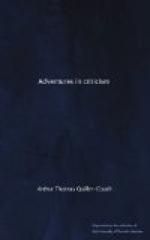MR. ANTHONY HOPE
Oct. 27, 1894. “The God in the Car” and “The Indiscretion of the Duchess.”
As I set down the titles of these two new stories by Mr. Anthony Hope, it occurs to me that combined they would make an excellent title for a third story yet to be written. For Mr. Hope’s duchess, if by any chance she found herself travelling with a god in a car, would infallibly seize the occasion for a tour de force in charming indiscretion. That the car would travel for some part of the distance in that position of unstable equilibrium known to skaters as the “outside edge” may, I think, be taken for granted. But far be it from me to imagine bungling developments of the situation I here suggest to Mr. Hope’s singular and agreeable talents. Like Mr. Stevenson’s smatterer, who was asked, “What would be the result of putting a pound of potassium in a pot of porter?” I content myself with anticipating “that there would probably be a number of interesting bye-products.”
Be it understood that I suggest only a combination of the titles—not of the two stories as Mr. Hope has written them: for these move on levels altogether different. The constant reader of The Speaker’s “Causeries” will be familiar with the two propositions—not in the least contradictory—that a novel should be true to life, and that it is quite impossible for a novel to be true to life. He will also know how they are reconciled. A story, of whatever kind, must follow life at a certain remove. It is a good and consistent story if it keep at that remove from first till last. Let us have the old tag once more:
“Servetur
ad inum
Qualis ab incepto processerit,
et sibi constet.”




